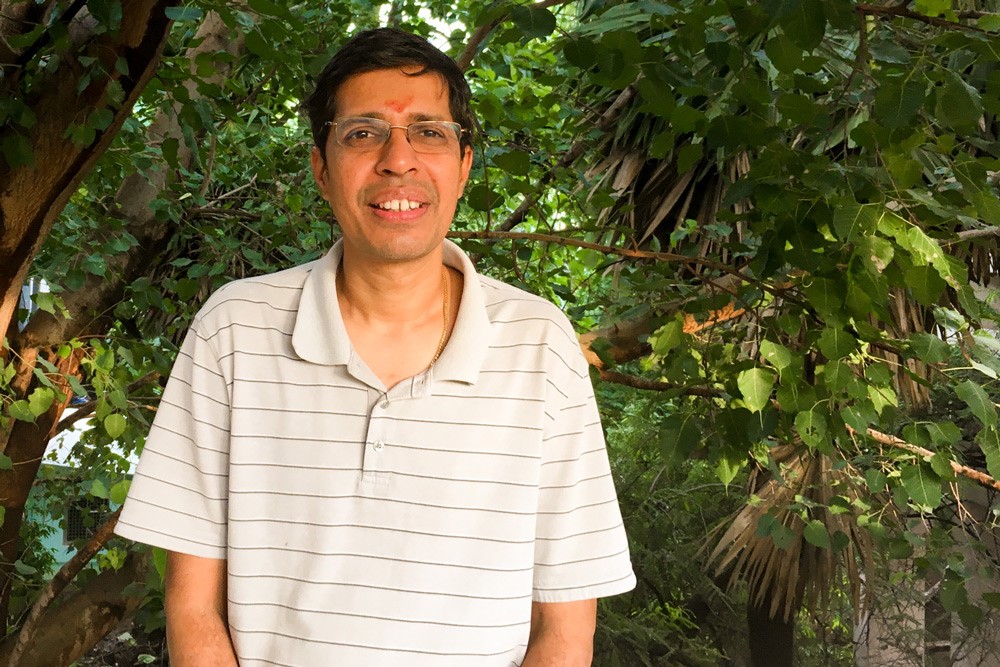It was around 12 in the afternoon when I reached the campus community hall. With a faint idea, but lot more curiosity, I walked into the hall on the second floor. With around twenty dancers standing around and following her mudras and expressions, Ms. Kalpana Jayanti, wife of Prof. Sreenivas Jayanti from the Department of Chemical Engineering at IIT Madras, was narrating texts in Telugu, while depicting suitable gestures and emotions. Seated on a chair and holding the nattuvangam thattu manai set — a wooden rectangular structure with a stick, which is used to provide rhythmic beats for dance — there she was, bearing a strict demeanour and looking keenly at her students. With a photograph of her guru Vempati Chinna Satyam, the doyen of Kuchipudi, right next to her, one could tell how much the guru-shishya relationship influenced her life.

Trained in Kuchipudi as a child in Vizag from various gurus including Pasumarthi Sitaramayya, Shri Rama Chandra Murthy, Bala Kondala Rao, Hari Ramamurthy and further training in Kuchipudi Art Academy from Vempati Ravishanker and then from guru Vempati Chinna Satyam himself, Ms. Kalpana decided to take her interest to the next level. Having pursued her Bachelors in electrical engineering, she did her Masters of Arts in music. Post a little period of time, she came to IIT Madras with Prof. Sreenivas Jayanti, started taking Kuchipudi classes since 2008 and joined the campus art initiative “Pratishrut” in the year 2015. She now has students ranging from the age of eight to forty including PhD and MTech scholars from insti, students from Vana Vani school, teachers and professors from Anna University. Akshaya, a PhD student from IIT-M said, “Ma’am dedicates her complete time to dance. Perfection is what she strives for”. Apart from being an active member in the field of dance within insti, Ms. Kalpana is an active member of the classical music club in insti.
After an intense hour of training, she spoke to The Fifth Estate about the her dance journey and endeavors in the institute.
Edited excerpts –
You did your undergraduate education in electrical engineering. Why did you decide to go in the MA Music route thereafter?
Post my undergrad, I had to make a choice. I was given complete liberty by Prof. Sreenivas Jayanti while making my choice. Either I could continue the engineering route or I could completely immerse myself into that art form which was my passion. In fact, I wanted to pursue my Masters in Dance, but since it was not offered as a part of the curriculum, I did my MA in Music.
On a different note, you are an active member of the classical music club in insti. What kinds of activities does your club undertake?
As a part of the classical music club, we organize vocal concerts as well as instrumental concerts within campus. To strongly encourage student participation and bring them together with the connoisseurs, we hold events like Tyagaraja Aradhana Day, Classical Music Day, Youth Fests etc. We do have an active participation from the residents of the campus during such events. But more often than not, the student participation turns out to be lesser than expected.
The patronage which other concerts get in insti is very different from the kind of patronage which classical concerts get. What is your opinion on this?
It frankly hurts me a lot to see a sparsely filled CLT or PhLT for a classical concert. Although I understand that students here are extremely busy with academics, I am also aware that it is more due to the common misconceptions associated with the art form because of which they do not turn up than their busy schedule. I always urge my students to attend concerts because the more you observe, the more you learn.
Would it be incorrect to assume that music gains predominance over dance at times and vice versa?
Absolutely. Dance and music are like “twin arts”. Music instills the emotion and feeling in a dancer and the dancer reacts to the music by means of thaalam and bhaavam. They can never be separated. Hence, I always ask my students who learn dance to learn music as well.
In the same context, we have a classical music club in insti but not a classical dance club. Has it ever crossed your mind to start one?
From the time we started the classical music club, the fact that we did not have a classical dance club has always been on my mind. I hope in the near future we have sufficient volunteering to start one.
Would you urge all students of our campus to learn some art form or the other?
Yes. I strongly urge every student to learn some art form or the other. It’s never too late to learn. However, classical dance and music in particular, demand years and years of patience, practice and focus. Hence in terms of priorities, I advise my students to give more importance to classical arts after academics.
What value, in your opinion, will this art form add to our lives?
The art teaches us two things – how to be and how not to be. The ‘how to be’ simply put is to be patient, focused and always enthusiastic towards learning. The ‘how not to be’ aspect is about not being selfish, insecure and jealous.

While she had a lot to tell about the art form and its influence on her students, her students too had a lot to tell about her. Prasanna, a teacher from Vani Vani school said, “The more we observe from her, the more we learn and understand the nuances of dance”. Pragnya, another student of hers, added that “she emphasises on understanding what we learn rather than mechanically reproducing what we see”. After an interesting discussion with T5E, Ms. Kalpana went back to doing that which she loved – teaching her students.



